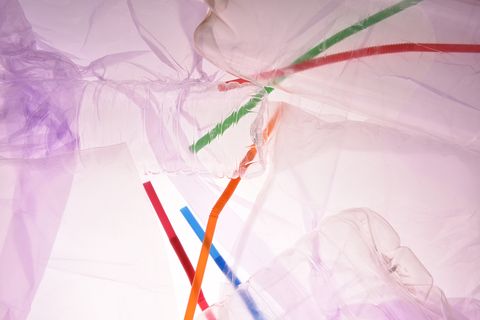[ad_1]
The Ingredients List – Breaking down the what, where and why of natural and eco-friendly beauty.
‘The beauty industry has a plastic problem’ – how many times have you read that headline? Quite a few we can bet. And they’re right, we do have an environmental and plastic crisis on our hands. We’re not about to go all climate change denier on you, don’t worry. However, when it comes to the beauty industry, it is also true that plastic might not be the big bad wolf it’s made out to be. Because, it turns out, alternatives aren’t always the most sustainable packaging option either.
Don’t believe us? There are actually four main arguments for plastic being one of the most sustainable packaging solutions in beauty: water consumption, the consumer’s ability to easily recycle, carbon footprint, and product shelf life. Of course, there are also instances where plastic definitely isn’t the best option, in particular black plastic and single-use plastic.
But, don’t just take our word for it, packaging technologists who look at lifecycle analysis (LCA) to determine whether a product is truly sustainable (we’re talking raw materials used, transportation, disposal, by-products and more) are on board as well. Controversially, when we look at the LCA of products within the beauty industry, often plastic comes out better than other alternatives. No, this isn’t fake news.
Sustainable Plastic Argument No. 1: Water Consumption
Water consumption is a huge environmental issue and is projected to be the next biggest problem facing the planet. Water is a critical part of the process of turning wood to paper, Dan Coppins packaging technologist for KMI brands says. Coppins explains that through this process, ‘a significant amount of water is lost, partly to fibres themselves and also to steam in the atmosphere.’
Essentially, ‘Anything that uses wood fibres will have a significantly higher water use,’ Coppins concludes. Plastic, in contrast, does not use anywhere near the same water consumption, and the water that is used, is then re-used.
Sustainable Plastic Argument No.2: The Consumer’s Ability To Recycle
Be honest, how many times have you actually repurposed that jar of moisturiser promising a new lease of life as a plant pot? Just because a product is eco-friendly and prides itself on you being able to give packaging a ‘second life’, doesn’t mean it’s going to happen.
It being possible to quickly and conveniently dispose of your empty beauty products is a huge piece of the puzzle, and plastic often makes this more doable.
When it comes to poor recycling stats, there is a lot of concern about whether plastic is actually being recycled. However, Coppins offers quite a simple reason for this. Recycling is still in its very (and we mean very) early stages. Only in 2003 was the Household Waste Recycling Act introduced and it was implemented by 2010. ‘This is the reason that recent reports have shown that recycling rates are lower than ideal, however the growth projection is significant in the sector,’ he adds. Tools like WRAP can help make sure your waste is properly recycled.
This content is imported from Instagram. You may be able to find the same content in another format, or you may be able to find more information, at their web site.
The Body Shop’s Plastics For Change initiative is also a perfect example of tackling this issue in a way that’s the antithesis of greenwashing. Recognising the abundant resource of recyclable plastic that already exists, in 2019 The Body Shop started using Community Fair Trade recycled plastic from Bengaluru, India. This three-pronged approach helps to drive social change, respects the environment and influences other businesses to follow suit. The Body Shop Body Butters, Body Yogurts, Body Scrubs and hair care bottles are all made from 100% PCR plastic, including up to 50% Community Fair Trade Recycled Plastic.
Sustainable Plastic Argument No.3: Carbon Footprint
‘The plastics that we’ve used are largely PP (polypropylene), which is the second most recycled plastic in the market,’ says Coppins. ‘We’ve used post-consumer recycled PP throughout our products too, which ensures a further reduction in carbon footprint (by reusing old material).’
The weight of products also matters. ‘Plastic is lighter weight than most materials (for example, glass, paper, and aluminium), this reduces the amount of energy required to transport the goods, further reducing the carbon footprint,’ Coppins explains.
This content is imported from Instagram. You may be able to find the same content in another format, or you may be able to find more information, at their web site.
Sustainable Plastic Argument No.4: Product Shelf Life
The shelf life of a beauty product is actually much longer than a lot of other industries’ packaging (think: food products), so whilst it’s not as bad as it could be, it still contributes to the problem. The main benefit of a longer shelf life simply means we don’t consume products as quickly. In addition, manufacturers produce bigger batches of product, which are, in turn, more carbon-conscious.
Durability is the reason natural deodorant brand Proverb uses plastic, after significant research into materials. ‘It needed to be strong, durable, scratch-resistant, dishwasher and travel proof, which is why we chose plastic — normal plastic,’ explains Kirstie Sherriff Co-Founder of Proverb.
Formulation also comes into play here. A product labelled as ‘clean‘ with no preservatives (e.g. parabens) might be thought of as better for the environment. But, a product that needs to be replaced every three months, housed in a glass jar that’s difficult to recycle, is far worse for the planet than a plastic bottle with a two year shelf life.
Unsustainable Plastic Example No.1: Black Plastic
KMI brands avoid black plastic where possible because it’s notoriously difficult to recycle. To sum it up: ‘automated recyclers use Infra-Red (IR) cameras to detect products going through processing,’ says Coppins, but black isn’t detected by these cameras. ‘Some colours that are not carbon black can be recycled, however, the dark colours mean that the re-use as PCR is limited to a much narrower re-use (often used for black plastic bin bags, which obviously go to landfill/incineration,’ he explains. For this reason, clear plastic is more circular.
Unsustainable Plastic Example No.2: Single-Use Plastic
Single-use plastic is an entire beast in itself and goes far beyond the scope of this article, but it’s not difficult to see why something used once and tossed away (though the definition of single-use is debated) is damaging for the planet. ‘The biggest issue with single use is where it does not have a re-use value, this is poorly considered design,’ Coppins explains. ‘Single use products are hard to move away from because we are addicted to convenience — there needs to be a shift in mentality on these items.’
Although it’s not a solution, Coppins notes a change in marketing language could also help shift consumer behaviours, for example, simply calling something ‘washable’ instead of single-use might encourage people to use them more than once.
To Conclude… A Perfect Packaging Solution Doesn’t Exist
As Chris DeArmitt points out in his book ‘The Plastics Paradox‘, ‘the best choice is the one that causes the least harm.’ For the beauty industry, the crux of the matter is, there’s no perfect packaging solution.
As Coppins explains, ‘the best’ and ‘most sustainable’ solutions are not mutually exclusive, ‘each element [of packaging] must be fully understood on its impact of sourcing, through to how it is disposed of. As these elements can have a wide range of variables, compromise must be made in some cases.’
So next time a brand is trying to sell you an eco-friendly option that promises to be the ‘perfect, most sustainable plastic-free solution’, dig a little deeper — you might be surprised to find plastic actually comes out on top.
This content is created and maintained by a third party, and imported onto this page to help users provide their email addresses. You may be able to find more information about this and similar content at piano.io
[ad_2]
Source link















